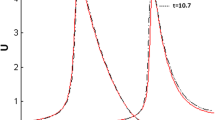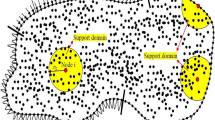Abstract
Diffusion plays a significant role in complex pattern formulations occurred in biological and chemical reactions. In this work, the authors study the effect of diffusion in coupled reaction-diffusion systems named the Gray-Scott model for complex pattern formation with the help of cubic B-spline quasi-interpolation (CBSQI) method and capture various formates of these patterns. The idea of Kronecker product is used first time with CBSQI method for 2D problems. Linear stability analysis of the reaction-diffusion system as well as stability of the proposed method is studied. Four test problems are considered to check the accuracy and efficiency of the method and found the stable patterns.










Similar content being viewed by others
References
Turing AM (1952) The chemical basis of morphogenesis. Philos Trans R Soc Lond Ser B 237(641):37–72
Jiwari R, Singh S, Kumar Aj (2017) Numerical simulation to capture the pattern formation of coupled reaction-diffusion models. Chaos Solitons Fractals 103:422–439
Sayama H (2015) Introduction to the modeling and analysis of complex systems. Open SUNY Textbooks, New York
Mittal RC, Rohila R (2016) Numerical simulation of reaction-diffusion systems by modified cubic b-spline differential quadrature method. Chaos Solitons Fractals 92:9–19
Liu H, Wang W (2010) The amplitude equations of an epidemic model. Sci Technol Eng 10(8):1929–1933
Dutt AK (2012) Amplitude equation for a diffusion-reaction system: the reversible Sel’kov model. AIP Adv 2(4):042125
Lee I-H, Cho U-I (2000) Pattern formations with Turing and HOPF oscillating pattern in a discrete reaction-diffusion system. Bull Korean Chem Soc 21(12):1213–1216
Maini PK, Woolley TE, Baker RE, Gaffney EA, Lee SS (2012) Turing’s model for biological pattern formation and the robustness problem. Interface focus 2(4):487–496
Vanag VK, Epstein IR (2009) Cross-diffusion and pattern formation in reaction-diffusion systems. Phys Chem Chem Phys 11(6):897–912
Fanelli D, Cianci C, Di Patti F (2013) Turing instabilities in reaction-diffusion systems with cross diffusion. Eur Phys J B 86(4):142
Shi J, **e Z, Little K (2011) Cross-diffusion induced instability and stability in reaction-diffusion systems. J Appl Anal Comput 1(1):95–119
Othmer HG, Scriven LE (1971) Instability and dynamic pattern in cellular networks. J Theor Biol 32(3):507–537
Nakao H, Mikhailov AS (2008) Turing patterns on networks. ar**v preprint ar**v:0807.1230
Nakao H, Mikhailov AS (2010) Turing patterns in network-organized activator-inhibitor systems. Nat Phys 6(7):544
Hata S, Nakao H, Mikhailov AS (2012) Global feedback control of Turing patterns in network-organized activator-inhibitor systems. EPL (Europhysics Letters) 98(6):64004
Udwadia FE, Koganti PB (2015) Optimal stable control for nonlinear dynamical systems: an analytical dynamics based approach. Nonlinear Dyn 82(1–2):547–562
Skandari MHN (2015) On the stability of a class of nonlinear control systems. Nonlinear Dyn 80(3):1245–1256
Saldi N, Yüksel S, Linder T (2016) Near optimality of quantized policies in stochastic control under weak continuity conditions. J Math Anal Appl 435(1):321–337
Liu K, Fridman E, Johansson KH (2015) Networked control with stochastic scheduling. IEEE Trans Autom Control 60(11):3071–3076
Cohen D, Nigmatullin R, Kenneth O, Jelezko F, Khodas M, Retzker A (2019) Nano-NMR based flow meter. ar**v preprint ar**v:1903.02348
Hale JK, Peletier LA, Troy WC (2000) Exact homoclinic and heteroclinic solutions of the Gray-Scott model for autocatalysis. SIAM J Appl Math 61(1):102–130
Kolokolnikov T, Ward MJ, Wei J (2006) Zigzag and breakup instabilities of stripes and rings in the two-dimensional Gray-Scott model. Stud Appl Math 116(1):35–95
Zheng Q, Shen J, Wang Z (2018) Pattern dynamics of the reaction-diffusion immune system. PLoS One 13(1):e0190176
Castelli R (2017) Rigorous computation of non-uniform patterns for the 2-dimensional Gray-Scott reaction-diffusion equation. Acta Appl Math 151(1):27–52
McGough JS, Riley K (2004) Pattern formation in the Gray-Scott model. Nonlinear Anal Real World Appl 5(1):105–121
Yadav OP, Jiwari R (2019) A finite element approach to capture Turing patterns of autocatalytic Brusselator model. J Math Chem 57(3):769–789
Jordehi AR (2015) A chaotic artificial immune system optimisation algorithm for solving global continuous optimisation problems. Neural Comput Appl 26(4):827–833
Matzinger P (1994) Tolerance, danger, and the extended family. Annu Rev Immunol 12(1):991–1045
McCoy DF, Devarajan V (1997) Artificial immune systems and aerial image segmentation. In: 1997 IEEE international conference on systems, man, and cybernetics. Computational cybernetics and simulation, volume 1, pp 867–872. IEEE
Kuo RJ, Chiang NJ, Chen Z-Y (2014) Integration of artificial immune system and k-means algorithm for customer clustering. Appl Artif Intell 28(6):577–596
Sablonnière P (2005) Univariate spline quasi-interpolants and applications to numerical analysis. Rend Semin Mat Univ Politech Torino 63(3):211–222
Sablonnière P (2007) A quadrature formula associated with a univariate spline quasi interpolant. BIT 47(4):825–837
Zhu C-G, Kang W-S (2010) Applying cubic B-spline quasi-interpolation to solve hyperbolic conservation laws. UPB Sci Bull Ser D 72(4):49–58
Zhu C-G, Kang W-S (2010) Numerical solution of Burgers–Fisher equation by cubic B-spline quasi-interpolation. Appl Math Comput 216(9):2679–2686
Kumar R, Baskar S (2016) B-spline quasi-interpolation based numerical methods for some Sobolev type equations. J Comput Appl Math 292:41–66
Mittal RC, Kumar S, Jiwari R (2020) A cubic B-spline quasi interpolation method for solving two-dimensional unsteady advection diffusion equations. Int J Numer Methods Heat Fluid Flow 30(9):4281–4306
Schumaker LL (2007) Spline functions: basic theory. Cambridge Mathematical Library, 3rd edn. Cambridge University Press, Cambridge
Sablonnière P (2004) Quadratic spline quasi-interpolants on bounded domains of \({\mathbb{R}}^d, d=1,2,3\). Splines, radial basis functions and applications. Rend Semin Mat Univ Politec Torino 61(3):229–246
Trefethen LN (2000) Spectral methods in MATLAB, volume 10. Siam
Zhang H, Ding F (2013) On the Kronecker products and their applications. J Appl Math. https://doi.org/10.1155/2013/296185
Simmons GF (2016) Differential equations with applications and historical notes. CRC Press, Boca Raton
Hundsdorfer W, Verwer JG (2013) Numerical solution of time-dependent advection-diffusion-reaction equations, vol 33. Springer Science & Business Media, New York
Acknowledgements
The author Sudhir Kumar would like to thank Council of Scientific and Industrial Research (CSIR), Government of India (File no: 09/143(0889)/2017-EMR-I).
Author information
Authors and Affiliations
Corresponding author
Additional information
Publisher's Note
Springer Nature remains neutral with regard to jurisdictional claims in published maps and institutional affiliations.
Rights and permissions
About this article
Cite this article
Mittal, R.C., Kumar, S. & Jiwari, R. A cubic B-spline quasi-interpolation algorithm to capture the pattern formation of coupled reaction-diffusion models. Engineering with Computers 38 (Suppl 2), 1375–1391 (2022). https://doi.org/10.1007/s00366-020-01278-3
Received:
Accepted:
Published:
Issue Date:
DOI: https://doi.org/10.1007/s00366-020-01278-3




